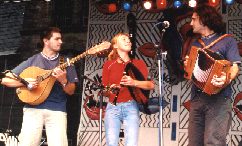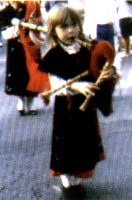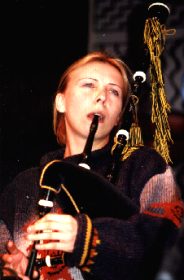

During the last couple of years, Galician music has become extremely popular internationally, thanks to musicians and bands like Carlos Núņez, Berrogüetto and Milladoiro. Though it was neglected in the international scene for a long time, still the music traditions have been always alive, at least in some of the lonelier regions. From one of these lonely Galician regions, where the music has even survived during Franco times, Susane Seivane hails, a young female piper with a bright future.
The province of Lugo in the North-East of Galicia is one of the remotest and loneliest parts of the North Western Spanish region. Set just besides Asturias, it is a mountain region with many natural highlights. If you call Galicia remote, then the mountainous inland part of the province of Lugo is even more remote; no wonder that in this remoteness the musical traditions could survive much better than in the Galician cities. Still today you can find in this region pipers who have played all of their life, and who effectively provided the fruitful grounds of the current boom of Galician music. You will find in every house a musician; mainly pipers and pandereiteras.
 Susane Seivane was grown up in these surroundings; and she loves the melodies from there: "Because the tunes have stayed very pure because of that remoteness; and you can feel that they have survived in their original style." Susane plays mainly traditional pieces especially of her region; they have been passed over, or were collected in field works. Besides those traditional pieces, she also plays tunes of contemporary composers and a couple of numbers she has composed herself.
Susane Seivane was grown up in these surroundings; and she loves the melodies from there: "Because the tunes have stayed very pure because of that remoteness; and you can feel that they have survived in their original style." Susane plays mainly traditional pieces especially of her region; they have been passed over, or were collected in field works. Besides those traditional pieces, she also plays tunes of contemporary composers and a couple of numbers she has composed herself.
With playing the bagpipes, Susane takes up a family tradition. The Seivane Bagpipe dynasty was started by Susane's grandfather who builds Galician bagpipes since 60 years. This tradition was taken over by Susane's father and uncle, and now also from her brother and sister. Susane herself works also in the workshop, but focuses on playing. Bagpipes sell very well in Galicia right now - no wonder, if you think that there are more than 15.000 pipers in the Northern Spanish region. After ordering a Seivane bagpipe, you have to wait at least a year, although four to five poeple work in the family business. Without ordering you won't get a bagpipe. "My father sometimes asks himself where all the pipers come from - so many bagpipes are sold!"
 Is it then something special that Susane as a girl plays the pipes? "Historically there have always been female pipers, already since a very long time", explains Susane, "of course much less than men. But there was a time when even for men piping did not give a good reputation, and for women it was of course even worse. These days, it is still very uncommon for a woman to play solo or to play in foreign countries. Still, the enormous boom for Galician piping is carried 50 % by women. Half of the current bagpipes pupils are girls. So it is only a question of time until more women will play as soloists and in more famous bands - Berrogüetto, for example, have already their female piper..."
Is it then something special that Susane as a girl plays the pipes? "Historically there have always been female pipers, already since a very long time", explains Susane, "of course much less than men. But there was a time when even for men piping did not give a good reputation, and for women it was of course even worse. These days, it is still very uncommon for a woman to play solo or to play in foreign countries. Still, the enormous boom for Galician piping is carried 50 % by women. Half of the current bagpipes pupils are girls. So it is only a question of time until more women will play as soloists and in more famous bands - Berrogüetto, for example, have already their female piper..."
With her 23 years, Susane can be quite proud to be internationally renowned as a great piper, yet the success is only the result of 20 years learning. To start playing the pipes with 3 is of course very uncommon. Susane's father often tells the story of Susane coming always into the workshop and trying to play everthing there. Then he decided to built her her own set of pipes, especially for her in children's size. This special pipes were tuned in D, according to her D chanter. With this children's bagpipe Susane had a significant advantage to the other children who were not brought up in a piper's family.
 Susane remembers: "I have then tried to play everything what I heards, on chanter, pipes and also small keyboards. That went from traditional songs via pop music to children's tape, quite everything." Soon Susane played in divers traditional bands; and already with 12 year she was offered to record a debut album. She rejected at that time, because she felt not mature enough for it. Her recording debut came only when she left her teenage days, and more and more people - starting with her family, but then also musicians like Milladoiro - tried to convince her to do that important step. When Rodrigo Romani (at that time still member of Milladoiro) offered her to produce the album, Susane was quite sure that the album would become a musical success. And the result was not only liked by herself, but also by the journalists in Spain and around the world
Susane remembers: "I have then tried to play everything what I heards, on chanter, pipes and also small keyboards. That went from traditional songs via pop music to children's tape, quite everything." Soon Susane played in divers traditional bands; and already with 12 year she was offered to record a debut album. She rejected at that time, because she felt not mature enough for it. Her recording debut came only when she left her teenage days, and more and more people - starting with her family, but then also musicians like Milladoiro - tried to convince her to do that important step. When Rodrigo Romani (at that time still member of Milladoiro) offered her to produce the album, Susane was quite sure that the album would become a musical success. And the result was not only liked by herself, but also by the journalists in Spain and around the world
By putting together her band, Susane remained true to her roots and musical heroes: "My musical heroes were always the old pipers; first of all my grand father, and then other old musicians that have either already died by now or are in their 80s or 90s." This influenced her musical ideas significantly. The base is traditional music, played on the gaita and traditional percussion, but also on instruments that were used to be played often in former times, like accordion and fiddle. To enrich the sound, she has added guitar and bouzouki to the band.
Since the release of her CD, Susane plays full time music. Still she hopes to find regularly some time to spend in her family's workshop, to learn how to build the pipes. Just out of interest....
Latest published CD: "Susane Seivane"; published by Boa/Dofol.
 You can win one of three albums.
You can win one of three albums.Photo Credit: All photos (exept no 4) by The Mollis: (1) Susane Seivane, (2) Sierra O Courel, remote mountainous region in the provice Lugo, (3) three members of the Susane Seivane Band, (4) Susane as three year old girl (photo taken from her debut album), (5) Susane Seivane.
Back to the content of FolkWorld Articles, Live Reviews & Columns
To the content of FolkWorld online magazine Nr. 16
All material published in FolkWorld is © The Author via FolkWorld. Storage for private use is allowed and welcome. Reviews and extracts of up to 200 words may be freely quoted and reproduced, if source and author are acknowledged. For any other reproduction please ask the Editors for permission.
